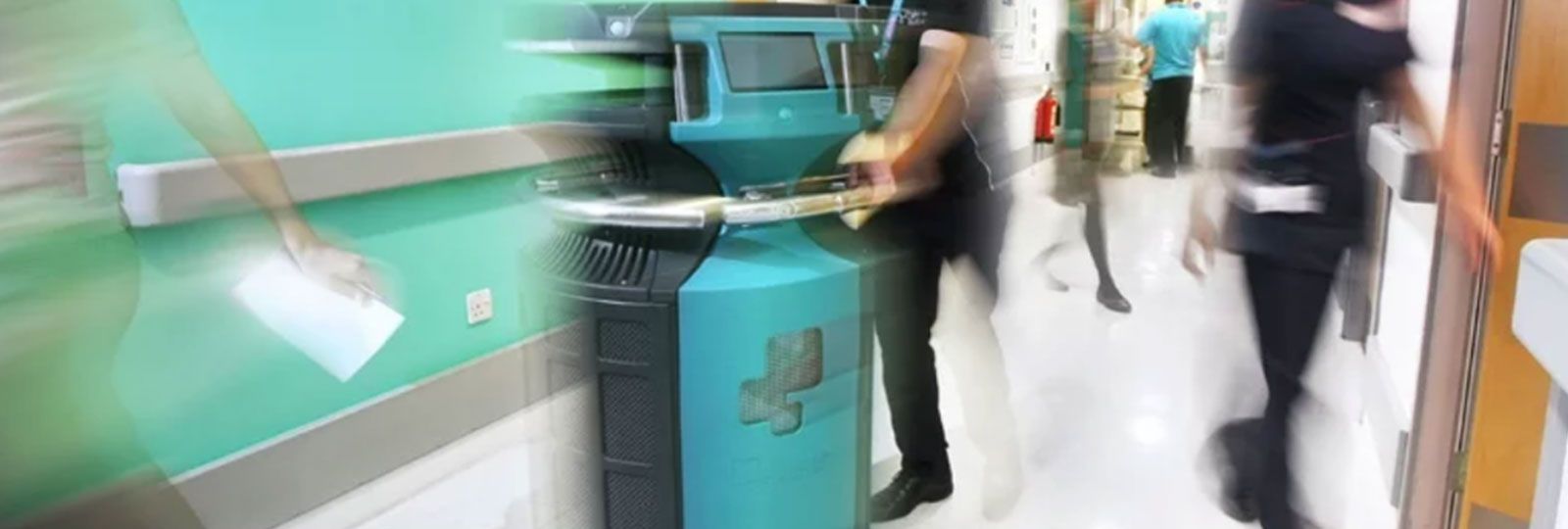
Hydrogen peroxide vapour (HPV) is effective at killing microorganisms such as MRSA and C.difficile in the hospital environment. Automated HPV decontamination systems have been found to reduce the risk of patients acquiring infection whilst in hospital. In fact, research shows they can achieve a log 6 (99.99%) reduction in infection rates.
No operator programming is required to use HPV decontamination systems, as they auto-calibrate to each environment to ensure the same outputs are achieved every time it is used. This ensures that all environmental variables are taken into account including temperature, relative humidity and absorbency of the environment to ensure a consistently authenticated decontamination process.
Here, we take a closer look at the typical process.
The HPV decontamination process
Step 1 – Preparing the environment for decontamination
- Before beginning the decontamination process, the room requiring treatment must be cleaned in line with the hospital’s infection control procedures.
- The temperature of the room should be set between 10 and 35 degrees.
- Operators should inform ward staff that the process will be taking place and restrict access to the treatment area by positioning ‘no entry’ signs on every access door.
- All absorbent material including curtains and bed linen should be removed from the room.
- All surfaces must be dry and exposed to maximise the area that the vapour will reach.
- Windows must be closed and any gaps in doors, walls and ceilings be sealed with DVI moisture impermeable tape.
- Fire sensors should be deactivated and isolated using a product such as CapKit.
- Ventilation must be switched off and ventilation points isolated, using products like VentCap, to stop any vapour from leaving the room.
- Operators must wear correct personal protective equipment.
- The machine should be positioned in the centre of the room and the brakes applied.
Step 2 – The decontamination process
Operators must follow instructions according to the specific machine being used for HPV decontamination. Below are the instructions for ProXcide™.
- ProXcide™ requires no operator programming and is safely activated remotely from outside the treatment space using the process monitor.
- The process monitor must be removed from the main unit by pressing the release button and positioned outside the room being treated.
- Operators must check that no one remains in the room before starting the decontamination process.
- The decontamination process is broken down into three stages:
- Injection phase – the unit will generate and circulate the HPV until the required concentration and humidity have been achieved.
- Dwell phase – the HPV gets to work by contacting all of the exposed surfaces and eliminating the microorganisms.
- Deactivation phase – the concentration of atmospheric hydrogen peroxide is actively reduced.
- The treatment process is visible at all times on the process monitor.
- Should operators need to stop the process, they can press the emergency stop button on the process monitor.
- Operators should not re-enter the room until the deactivation phase shows as complete on the process monitor. This will be indicated by a green thumbs up.
- The ProXcide™ decontamination process is completed in under 2 hours. Exact times will vary depending on the environmental parameters, size and contents.
Step 3 – Post decontamination
- Before re-entering the room, operators must check the area is safe to enter by using a portable gas monitor.
- If the reading is less than 1 PPM, the room is safe to enter. If it is between 1 and 2 PPM, it is safe to enter the treatment space for up to 15 minutes in any eight-hour period to ventilate the room and aid aeration by opening windows. If the reading is greater than 2 PPM then further deactivation time is required and the treatment space must not be entered. If this is the case, select 15 minutes deactivation on the process monitor.
- When the PPM reading is safe, operators can unplug the process monitor power cable and return it to the main unit, clicking it into place.
- The main unit should then be unplugged and the VentCaps, CapKits, tape around windows and doors and the warning signs removed.
- The room should be returned to its normal layout and the fire sensors reactivated.
- The operator checklist should be completed and signed by operators to finalise the process.
- The unit should then be wiped down using a dry cloth to remove any residual condensation, before being covered and returned to a secure storage area. Only mild cleaning products such as normal detergent or mild alcohol wipes should be used to clean the plastic parts of the system.
- Operators should remove and dispose of personal protective equipment.
HPV decontamination is an effective method for sterilising and disinfecting surfaces contaminated with microorganisms such as MRSA and C.difficile. Automated HPV decontamination systems are completely safe to use, and as you can see from the steps above, no operator programming is required as the system automatically adjusts for the specific environment. And as the process is completed it under 2 hours, it means minimum disruption to the day-to-day runnings of the hospital.





